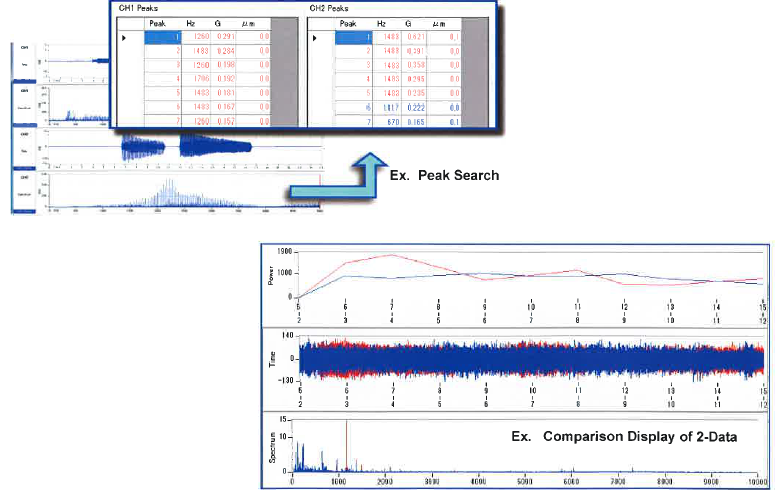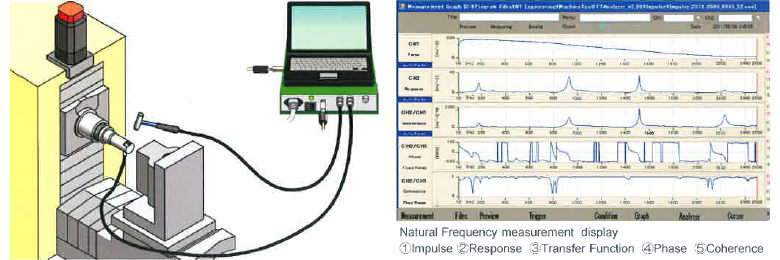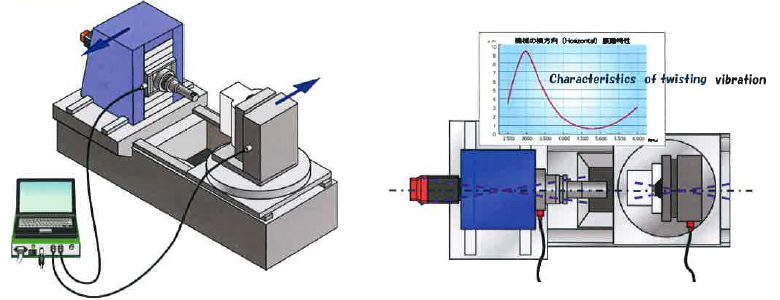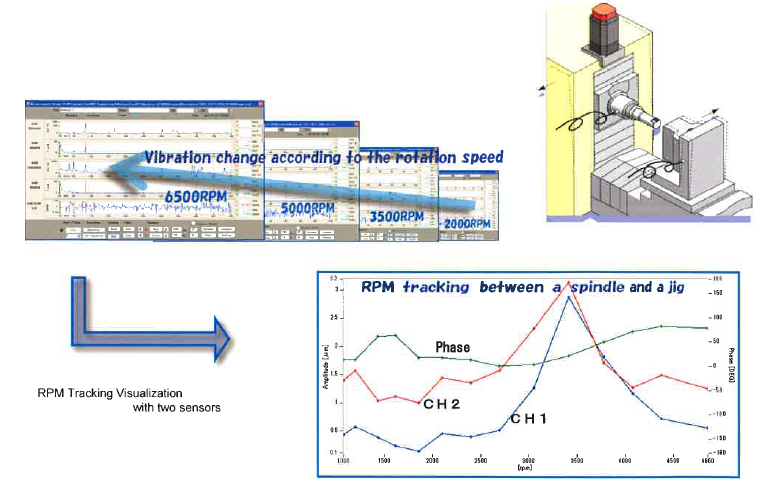- Home >
- New products >
- Machine-Tool FFT Analyzer
NEW PRODUCTS
Machine-Tool FFT Analyzer
Vibration Measurement
- With this product, you can check what frequency vibration is generated and the greatness to investigate the vibration influencing the machining process. There are two measurement types; 1CH and 2CH input measurements.
- This analyzer makes a vibration measurement with an acceleration sensor and displays the vibration greatness in waveform with time and the frequency spectrum.
- Most of vibration frequency influencing machining accuracy is in low-frequency range of less than 2000Hz. Our FFT Analyzer focuses on finding out such low-frequency range.

Visualization by “Peak Search” of Vibration and “Comparison Display” of Data
- One of the visualizing functions is the “Peak Search”, by which the peak frequencies are instantly shown in descending order with a click of the button. Each frequency [Hz] is displayed with the acceleration value [G] and the amplitude value [μm].
- The separately obtained different two data are overlaid on the display to make comparison and characterization easier.

Measurement of Natural Frequency
- Vibration in machining process is largely influenced by the natural vibration characteristic of the machine. For improvement of machining accuracy affected by vibration or troubleshooting of chatter vibration, learning about the natural frequency is very important.
- Measurement of natural frequency is made as follows;
(1) Excitation force on the measurement target is input with an impact hammer.
(2) The natural vibration is detected by an acceleration sensor as an output.
(3) The measurement result is expressed in ratio of the output and input as a transfer function. - Higher-mass machine structures vibrate slowly and small cutting tools vibrate rapidly. If the measurement target has spring characteristics, the output/ input ratio becomes larger and the damping time becomes longer.

Visualization of Vibration Characteristic of Components Natural Frequency, Dynamic Rigidity and Damping Ratio
- Vibration stiffness [softness or hardness] of the measurement target in dynamic condition is expressed in compliance [μm/N (Hz)]or dynamic rigidity [N/μm (Hz)] to show how it changes by which vibration frequency. To express the degree of damping to the excitation force [convergence time], damping ratio is used. [General reference valueζof is 3%.]

Measurement of Swaying Vibration
- Twisting vibration of machine columns or jigs produced from machining vibration, so-called swaying vibration is measured with two sensors.
- Two sensors are axisymmetrically put on a machine component producing twisting vibration. Measurement is made with changing the number of rotations. The characteristic of the twisting vibration is understood from the relationship of the amplitude and the phase between the measured two points. The result is fed back, for example to the cutting condition.

PPM Tracking – Visualization of Machine Vibration by Data Comparison of Each Spindle Speed
- Between two measurement points, the relationship of the amplitude and the phase measured at different spindle speeds is compared. The convenient “PPM Tracking” graphically shows amplitude and phase measured between a spindle and a jig in order of spindle speed and makes the phase relationship understandable.

Convenient Stability Pocket Drawing – Tool of Natural Frequency Measurement
- Even among engineers who know the “Stability Pocket Method” is effective against regenerative chatter vibration, only a limited number of them have actually used the method. To put the method into practice, measurement of natural frequency and calculation of stability pocket lobe is necessary. FFT Analyzer has a stability pocket drawing function, which makes the process easier.

Standard Package / Machine Tool FFT Analyzer Ver.3
- FFT Main Module ――― 2ch-input
Size W:233mm×H:49mm×D:326mm
Weight 2.3kg
Voltage 100~240VAC
- FFT Vibration Analysis Software (Installed)
Interface USB2.0
- Standard Package
Main Module and Special Computer (1 each)
Acceleration Sensors (Built-in amplifier) (2)
Voltage Sensitivity 10mv/m/s2 or 5mv/m/s2
Impact Hammer (1)
Cables
Main power cable, USB cable and acceleration sensor cable
Items above are contained in a carrying bag.
Measuring Function / Machine Tool FFT Analyzer Ver.3
- Vibration Measurement
2-input / 1-input
- Natural Frequency Measurement
The output / input ratio of the measurement target excited with the impact hammer is expressed as a transfer function.
- Swaying Vibration Measurement
The vibration amplitude and the phase difference between the rotating speed of the measured two points are indicated.
Options
- Compact impact hammer
- Compact acceleration sensor for measurement of high-frequency vibration
- Special cable and converting connector for acceleration sensor
